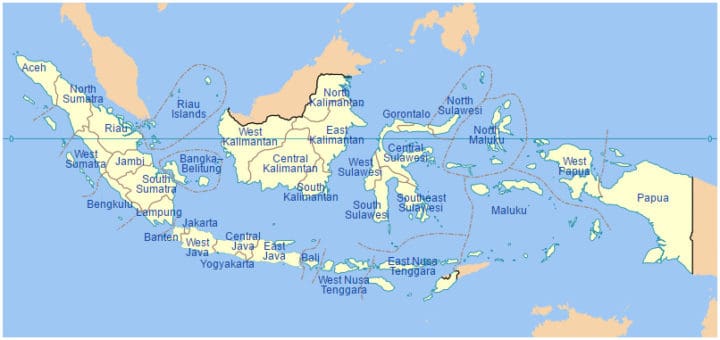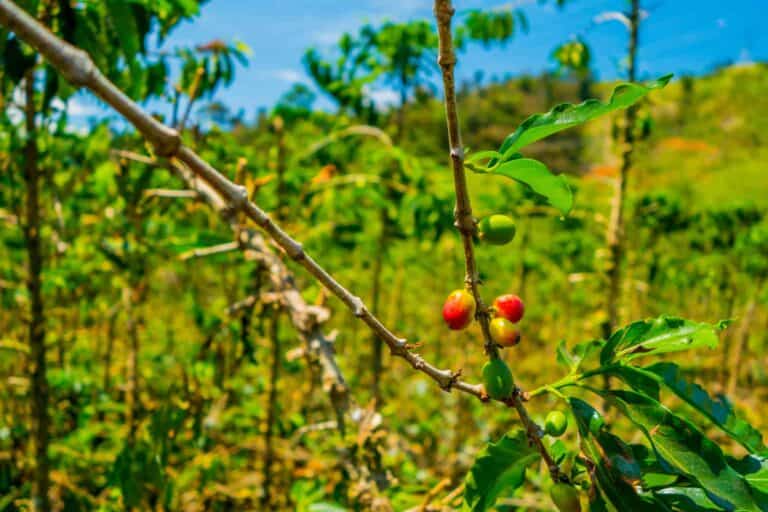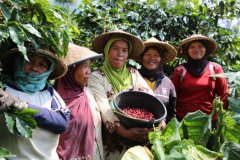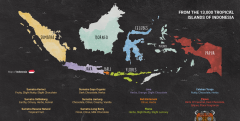Sumatra Lindong Mantenin Flavor Taste Characteristics Indonesia's four major coffee producing areas How to wholesale Indonesian coffee
The Indonesian archipelago is by far the largest island in the world-13677 islands, spread over 5120 km (3200 miles) of tropical waters. When superimposed on a map of North America, this means that Indonesia stretches from Oregon to Bermuda. 4/5 of the middle area is occupied by the ocean, and many of the islands are small, just exposed rocks, and there may be some seabirds. But Indonesia has 3000 islands to live in, and New Guinea and Borneo rank second and third in the world (after Greenland). Of the other major islands, Sumatra is slightly larger than Sweden or California; Sulawesi is roughly the size of Britain, and Java alone is as large as England or New York. The total land area is 2.02 million square kilometers (780000 square miles). When it comes to Indonesian coffee, you should have heard of Indonesian Kopi Luwak, and some coffee lovers may still know Manning, but do you know it? Manning Coffee varies by name depending on the producing area. So what coffee producing areas are there in Indonesia?
Coffee is produced on the following islands:

Sumatra
For years, coffee from the largest island in Indonesia has been simply called "Mandheling" or "Lintong". This hardly explains their provenance, let alone their rich and complex characteristics. Many buyers are fully accustomed to the stale, dull, musty taste of Sumatran coffee. In fact, in the worst case, Sumatran coffee may be earthy, mushroom and inconsistent. However, the best and freshest examples can show complex herbal features, clean, bright cups and interesting flavor features. Like Colombia and Kenya, Sumatra produces two crops a year. These are usually in May / June (secondary crops) and September / October (major crops).
There are few coffee farms or cooperatives in Sumatra. On the contrary, a large number of small farmers (most farms with an average area of two hectares or less) sell a small amount of coffee in the local rural market. Coffee is rarely the only crop on these small farms, but it provides a major cash income for about 5 million people.
Java
Java, which is now almost synonymous with coffee, can also produce some high-quality specialty coffee. The island lies between Sumatra in the west and Bali in the east. Most of the Arabica coffee on the island is grown on five government-owned estates covering a total area of more than 4000 hectares-Blawan (alt. Belawan, Blauan), Jampit (alt. Djampit), Kayumas, Tugosari and Pancoer. These vast plantations gather on the volcanic Yizhen Plateau in the eastern part of the island, about 1370 meters (4500 feet) above sea level. They were established by Dutch colonialists more than 100 years ago and then reactivated by the Indonesian government after independence in the late 1950s. Arabica coffee has a long history in Java-it was first introduced to the island in the late 17th century by the Dutch East India Company, which shipped the first goods from Java to Europe in 1711. Java coffee is usually fully washed and is famous for its low acidity and heavy body.
Sulawesi
Most of the coffee in Sulawesi is produced by small farmers, who account for about 95% of the island's output. Although some coffee is completely washed, the vast majority of coffee is still produced using the semi-washed Giling Basah method. Sulawesi's most famous coffee is Toraya Coffee, a multi-dimensional coffee grown in the southeast highlands and famous for its rich and full-bodied body. Sulawesi Toraya Coffee grows on the high-altitude island of Sulawesi, formerly known as Celebes (Dutch colonial name), in the middle of the Indonesian Malay archipelago. Therefore, Toraya Coffee is also called Celebes.
Toraja coffee is processed by the GilingBasah wet shell process, which produces raw coffee beans without husks, which have been ground but not yet roasted) with a distinct dark hue. The semi-dry processing of coffee beans sometimes leads to uneven roasting and has a significant impact on the characteristics of brewing coffee.
Flores
Compared with other Indonesian islands, Flores is relatively small, spanning 200 miles from beginning to end. The island is famous for its rich vegetation and is one of the few places where the endangered Komodo dragon can be seen. However, its coffee is still the cornerstone. Most of the coffee is produced in the town of Bajawa, which is 1200 to 1800 meters above sea level. Flores has a rugged terrain with several active and inactive volcanoes. The ash from the volcanic eruption creates fertile ridge soil, which is ideal for producing organic coffee.
Farmers in Flores use the wet shelling process. This method is combined with Flores's position to give the coffee a sweet milk chocolate flavor with floral, woody and syrup-like body.

Bali
Bali is famous for its beautiful beaches, coral reefs and yoga and meditation resorts. This tropical paradise offers some of the best coffee that Indonesia and the world must provide. Most coffee grows in the Kintamani Highlands between the Batukaru and Agung volcanoes. As in Flores, volcanic ash helps keep the soil fresh to grow high-quality coffee plants.
Most farmers use the washing process for coffee beans. This gives the coffee a rich taste without tasting too bitter. Flowers, lemons, chocolates and walnuts are typical of Balinese coffee.
If you are interested in coffee wholesale in Indonesia, you can choose to take a look at the introduction of different producing areas first. It is OK to choose raw beans or cooked coffee from different producing areas after understanding. In general, you can see the simple flavor description, growth conditions and cup test characteristics of coffee.
Important Notice :
前街咖啡 FrontStreet Coffee has moved to new addredd:
FrontStreet Coffee Address: 315,Donghua East Road,GuangZhou
Tel:020 38364473
- Prev

Guide to Indonesian Coffee unique Wet planing Coffee beans Mud herbal flavor
Today, about 90% of Indonesian coffee comes from Robusta, unlike the now famous Rosa coffee, which is usually used for commercial grade coffee. Qianjie brings you Indonesian coffee from many aspects. Indonesian coffee history Arabica coffee plant was first introduced to Indonesia by the Dutch East India Company in the 17th century, while Indonesia is still
- Next

Introduction of Indonesian Coffee exported to Indonesian Coffee Plantation besides Kopi Luwak
Indonesia is one of the largest coffee producers and exporters in the world. Most production forms the lower quality Robusta type. Indonesia is also famous for having many specialty coffee, such as kopi luwak Indonesian Kopi Luwak (known as the most expensive coffee in the world) and kopi Mandailing Manning Coffee (see below). In terms of agricultural products, coffee
Related
- Detailed explanation of Jadeite planting Land in Panamanian Jadeite Manor introduction to the grading system of Jadeite competitive bidding, Red bid, Green bid and Rose Summer
- Story of Coffee planting in Brenka region of Costa Rica Stonehenge Manor anaerobic heavy honey treatment of flavor mouth
- What's on the barrel of Blue Mountain Coffee beans?
- Can American coffee also pull flowers? How to use hot American style to pull out a good-looking pattern?
- Can you make a cold extract with coffee beans? What is the right proportion for cold-extracted coffee formula?
- Indonesian PWN Gold Mandrine Coffee Origin Features Flavor How to Chong? Mandolin coffee is American.
- A brief introduction to the flavor characteristics of Brazilian yellow bourbon coffee beans
- What is the effect of different water quality on the flavor of cold-extracted coffee? What kind of water is best for brewing coffee?
- Why do you think of Rose Summer whenever you mention Panamanian coffee?
- Introduction to the characteristics of authentic blue mountain coffee bean producing areas? What is the CIB Coffee Authority in Jamaica?

